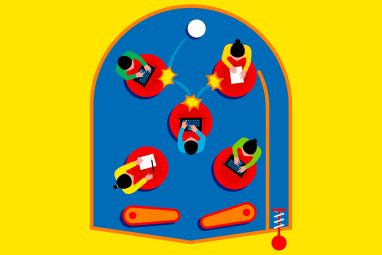The Trouble With Your Innovation Contests
Not all innovation contests should be winner-takes-all or judged by senior executives. New research shows how to structure contests to meet specific goals.
Topics
News
- More than 80% of Saudi CEOs adopted an AI-first approach in 2024, study finds
- UiPath Test Cloud Brings AI-Driven Automation to Software Testing
- Oracle Launches AI Agent Studio for Customizable Enterprise Automation
- VAST Data and NVIDIA Launch Secure, Scalable AI Stack for Enterprises
- How Machine Identity Risks Are Escalating in AI-Powered Enterprises
- How Agentic AI Is Reshaping Healthcare

John Holcroft/Ikon Images
Ever wonder why matchboxes usually have a sandpaper strike on only one side? Well, it didn’t used to be that way. For decades, people could use either side of the matchbox to light their matches. But this changed in the early 1900s, when a worker at a Swan Vesta factory pointed out this apparent redundancy in the design and suggested that the company could reduce production costs substantially by placing sandpaper on only one side of the matchbox. This simple idea has influenced matchbox design ever since, leading to millions of dollars in savings for manufacturers.
Employees often have creative ideas that can help their organizations. These breakthroughs range from ways to make the production process more efficient, such as the matchbox design proposal, to ideas for new products, like Frito-Lay’s Flamin’ Hot Cheetos. Those very spicy chips were invented by Richard Montañez, at the time a janitor at the Frito-Lay Rancho Cucamonga plant. According to Montañez, he was inspired by a video message from the president of the company that encouraged employees to “act like an owner.” He pitched the chili-based snack to company executives, which led to Flamin’ Hot Cheetos becoming one of Frito-Lay’s most lucrative products. Other innovative ideas that stemmed from employees in nontraditional ways include the McDonald’s Happy Meal and Southwest Airlines’ humorous approach to its flight safety instructions. But how can companies best tap into the vast array of ideas that their employees dream up?
Innovation contests have become a popular answer. The idea behind these contests is good, but new research shows that the way many organizations conduct them needs improvement. The biggest takeaway: When leaders run innovation contests, they need to design the contest to match the organization’s objectives.
Some key decisions that leaders must weigh:
- Who should judge the contest?
- Are we seeking highly useful or highly novel ideas?
- Should we use a winner-takes-all approach, or offer multiple prizes?
Our research shows that these factors will significantly shape the number and diversity of participants, how much time they spend developing the ideas, and the type and quality of their ideas. Let’s explore the implications of each approach and how to choose among them, depending on your organization’s goals.
How to Best Structure Contests: New Insights
In innovation contests, the best submissions are rewarded with a prize, and the possibility of winning motivates employees to share their brainstorms with organizational leaders. That’s important so that valuable ideas don’t stall out with middle management. Contests also come with a clear set of rules and instructions that inform employees about what types of ideas the organization is seeking. These motivating and directing elements have made contests popular methods for collecting ideas for hundreds of years. For instance, Napoleon held contests that yielded important advances in military readiness, like canned goods and margarine, which made food easier to transport. And modern-day businesses continue to use contests to elicit innovation, like Facebook’s famous annual hackathons, which have been cited as one of its most important innovation drivers and have led to features like chat and calendars.
Although contests are not a new idea, there are still many unknowns regarding the best ways to structure contests. Our recent research provides new insights into the implications of contest design. In the contests held for our research, participants were asked to submit their most creative ideas to make surveys more engaging, with the creativity of each submission to be subjectively assessed by a panel of judges.
This raises a crucial point about creativity contests: Because the creativity of an idea cannot be objectively measured, the judges’ opinions of what is and is not creative ultimately determine the winners. The selection of the judges is, therefore, critical to the outcome of the contest because what one person might consider to be highly creative, another might not. You might have heard the expression “beauty is in the eye of the beholder.” The same holds true for creativity: Not all judges will make the same assessment of the creativity of a particular idea.
This subjectivity in determining the winners of a contest creates uncertainty in the minds of the potential participants. It might be difficult for employees to estimate their chances of winning if they are uncertain about the opinions and preferences of the judges.
In contrast, in a contest where the winner is objectively determined, it is easier to estimate one’s chances of winning. For example, the top 10 finishers in the open division of the Boston Marathon earn $5,500 to $150,000, making it a lucrative race among elite marathon runners. Since winners are objectively determined based on their race times, a person could estimate — with reasonable precision — their chances of winning money at the Boston Marathon, by comparing the race’s historical top-10 placement times to their own marathon completion times.
Now imagine if prize money were allocated based on who completed the marathon in the best costume. In this case, the winners would be determined subjectively, based on the opinions and preferences of those judging the costume contest. This subjectivity would create additional uncertainty in the minds of participants as to how likely they would be to win a prize, which would impact their decision whether to participate and how much effort to exert.
Based on our research findings, the following are key questions to consider when sponsoring an innovation contest.
Who Should Judge the Contest?
Our study examined how the judges’ identities in an innovation contest influence the participation and effort made by individuals who are invited to enter the contest. We found that individuals engage in perspective-taking to predict the tastes of the judges — and the more confident individuals are about their ability to guess what the judges find creative, the better they can estimate their chances of winning. Our research shows that individuals feel they can better understand the perspectives of those they resemble, which increases their confidence in their estimates of the judges’ opinions of what is highly creative. This means that when the judges are more similar to prospective participants, uncertainty is reduced. Our study tested whether individuals are more likely to participate in a creative idea-sharing contest when the judges are more similar or less similar to them. The result: Individuals submit more ideas to these contests when the judges are their peers — people with their same job role, whose tastes regarding creativity are easier to estimate — than when the judges are their managers, whose tastes are harder to estimate.
Which Is the Priority: Useful Ideas or Novel Ideas?
Our study also showed that the identity of the judges influences the features of the submitted ideas. The creativity of an idea is based on two features: the usefulness and novelty of the idea. As contest participants use perspective-taking to estimate the tastes of the judges, they specifically consider what the judges are more likely to value: highly useful ideas, which can be practically implemented and have a clear effect on organizational value; or highly novel ideas, which are especially out-of-the-box and counter-normative.
Here’s the takeaway from our research: When the judges are managers, participants submit more useful ideas. Participants estimate that managers will likely care relatively more about the usefulness of the ideas, since managers will bear the implementation costs.
When the judges are people’s peers, participants submit more novel ideas — and the overall creativity of the best ideas is higher. Thus, when managers hold a creativity contest, they should carefully select the judges, as this decision will likely influence both participation rates and the features of the submitted ideas.
How Many Prizes Should Be Offered?
Another important design element of contests is the number of prizes that are up for grabs. There is a large variety of contest prize structures, ranging from winner-takes-all models, where only one contest submission wins a large prize, to participation-award models, where every legitimate submission gets a prize. Selecting the optimal prize structure for a contest is always important, but when judging happens subjectively, like in a creativity contest, it becomes even more meaningful.
When evaluation is objective and there is a direct link between higher effort and higher performance, participants can accurately assess what their output is likely to be, given their level of exertion and ability. As a result, only top performers are likely to believe that they have a higher likelihood of winning a prize when the number of prizes increases from one prize to multiple prizes. Low performers might predict that even though the number of winners has increased, their output will still likely fall below the threshold for a prize, so the increase in the number of prizes will not influence their participation decisions.
Think back to the Boston Marathon example: The vast majority of participants in the race have race times that are much slower than the top 10, so their participation decisions are unlikely to be affected by whether the race offers a winner-takes-all prize versus stratified prizes for the top 10 finishers. In a contest with a subjective evaluation — like a costume contest — where uncertainty about the evaluator’s tastes makes it unclear who the top performers might be, increasing the number of prizes will likely positively influence the participants’ estimated likelihood of winning. Based on this idea, our study also examined whether participation increases when several smaller prizes are offered versus one larger prize. Our finding: Offering several smaller prizes increases participation but only for certain individuals — those who are demographically underrepresented in creative endeavors.
Why would this effect be present only for those who are demographically underrepresented? We attribute it to differences in a person’s confidence that their creativity will be recognized by others. Young males are often thought of as innovators. The fact that famous innovators like Mark Zuckerberg, Evan Spiegel, and Jack Dorsey are male and were in their 20s when they first developed their ideas helped create this societal perception, and research on this point is persuasive. The doctoral dissertations of young males are often viewed as more innovative, even holding constant the actual creativity level of the work.1 Young males are also more likely to receive venture capital funding for their business ideas than entrepreneurs from any other demographic group.2 So it’s not surprising that young males are likely more confident that they can win a contest, even when competing for a winner-takes-all prize.
Given that perception, it also makes sense that older individuals and/or females might feel less optimistic about their chances, making a winner-takes-all contest especially unenticing for these individuals, and making them more likely to participate in contests with a larger number of smaller prizes. This is consistent with what our research found: Older individuals and/or females submit significantly more ideas when they are competing for multiple, small prizes rather than a single, large prize.
There is one potential drawback of replacing a winner-takes-all prize structure with multiple, smaller prizes: It might negatively affect the effort participants put into their idea development, leading to lower-quality ideas. Our research showed that the average novelty and overall creativity of the ideas decreases when multiple, small prizes are offered rather than a single prize. The adverse effect on novelty showed up even in the best submissions, suggesting that participants exert less effort to submit highly novel ideas when they compete for multiple, small prizes. Another takeaway: Participants reduced the amount of time they spent developing their ideas, and they created significantly shorter submissions, when competing for multiple, small prizes rather than one, large prize.
Innovation Contest Design Lessons for Leaders
Creativity is the fuzzy front end of innovation. Especially today, as more and more mundane and repetitive tasks are taken over by algorithms and machines, we want employees to do what they are uniquely qualified for: being creative. Although employees likely have many creative ideas, managers need to motivate and facilitate the development and sharing of them. Innovation contests offer an effective way to get employees interested in sharing their ideas, but from the start, leaders must carefully decide the organization’s ultimate goals so that they can then tailor the design of the contest to achieve those objectives.
Consider these guidelines:
- If you want to make sure you are eliciting ideas from all of your employees — in other words, that all voices are heard — you will want to design a contest with multiple, smaller prizes.
- If you are interested in getting a lot of useful ideas that will lead to continual process improvements, you will want to use managers as judges.
- If you are interested in eliciting one extremely good idea, then it is important to offer a single, large prize and have the judges be the peers of the contest participants. This will result in extra effort in idea development and a push for out-of-the-box thinking.
Another great advantage of contests is that organizational leaders can simply append them to existing performance evaluation and reward systems. Leaders don’t need to completely overhaul these systems in order to motivate idea sharing.
Finally, and perhaps most importantly, organizations don’t need to limit themselves to one contest. Instead, leaders can run different contests, with different designs, depending on organizational priorities at the time. So don’t wait to tap into employee creativity. Conduct innovation contests, but first think carefully about what’s important to your organization, and design your contests accordingly.





